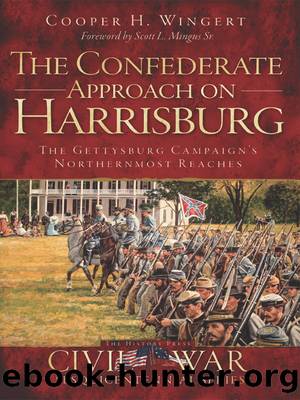The Confederate Approach on Harrisburg by Cooper H. Wingert

Author:Cooper H. Wingert [Wingert, Cooper H.]
Language: eng
Format: epub
Tags: History, Military, United States, Civil War Period (1850-1877), State & Local, Middle Atlantic (DC; DE; MD; NJ; NY; PA)
ISBN: 9781609498580
Google: biFSvgAACAAJ
Publisher: History Press
Published: 2012-01-15T16:05:38+00:00
Chapter 9
Jenkins Reconnoiters Harrisburg
At Oysterâs Point, the âwarm, sun shiny dayâ of June 29 began when reveille sounded as usual at 5:00 a.m. âWe have pretty high living now,â penned an enthusiastic Joseph Boggs Beale of the 33rd PVM, who described the vicinity that morning:
All the farm houses are derted [sic] and fresh bread, pots of apple butter, buttermilk, fresh butter, chickens, pigs, potatoes, molasses, etc. etc. are brought in by the boys who go out foraging. Old hats, bonnets, and cloths and pieces of furniture have been brought into camp. One old man in our company captured a side saddle at an empty farm house, after which he deserted taking it with him, and his equipments, knapsack, and even his musket he held onto. Guards have been stationed at these, formerly unprotected houses. Of course they live on the fat of the land, if there is any left. We now see nobody but soldiers, all citizen have cleared out, and it is said when two farmers go to cross the Bridge to Harrisburg the guard there captures one to work on the entrenchmentsâ¦The fences here are broken and the cattle are running at large over the countryâ¦There does not seem to be any excitement here, and all are happy and full of fun.325
Company I of the 71st NYSNG moved from its picket line of the previous night to near Limekiln Lane. A cobblerâs stall became headquarters, and the company split in two, with half skirmishing with the Rebels in Samuel Shoppâs cornfield while the other half went foraging. âPigs and chickens were captured, and cooking began in the kitchen of a deserted house close by,â recalled one New Yorker. âApple butter, too, the prevalent institution in Pennsylvania was found in plenty.â The company continued that process, one half relieving the other after a short amount of time, until Griffinâs artillerists at the Peace Church crashed their picnic with a few well-directed three-inch shells, âwhich shrieked and crashed through the branches, bursting over us, round us, and many of them altogether too near to be pleasant[.]â326
To make matters worse, the New Yorkers were fired upon by other Yankees in their rear, which, though it caused no injuries, was not agreeable. A flag of truce (a handkerchief hoisted by a ramrod) soon rectified the situation. The men of the 71st were under strict orders to fire only three or four volleys during the skirmishing, as an engagement (small or large) was expected that day and they should reserve ammunition for it.327 The skirmishing became heated, not only through gunfire but also when several Yankee pickets who were close enough to exchange words with their Southern counterparts caused a ruckus with some profanity, which led to more firing and a shell landing within thirty feet of a group of fleeing civilians.328
Baldy Smith decided to make the first substantial move on June 29, sending forward Lieutenant Frank Stanwoodâs cavalry detachment from Carlisle Barracks. Stanwood engaged and drove in the Confederate pickets on the
Download
This site does not store any files on its server. We only index and link to content provided by other sites. Please contact the content providers to delete copyright contents if any and email us, we'll remove relevant links or contents immediately.
The Radium Girls by Kate Moore(11593)
100 Deadly Skills by Clint Emerson(4675)
The Templars by Dan Jones(4549)
Rise and Kill First by Ronen Bergman(4539)
The Doomsday Machine by Daniel Ellsberg(4235)
The Rape of Nanking by Iris Chang(4007)
Killing England by Bill O'Reilly(3893)
Hitler in Los Angeles by Steven J. Ross(3791)
Stalin by Stephen Kotkin(3715)
12 Strong by Doug Stanton(3410)
Hitler's Monsters by Eric Kurlander(3150)
Blood and Sand by Alex Von Tunzelmann(3046)
Darkest Hour by Anthony McCarten(3011)
The Code Book by Simon Singh(2843)
The Art of War Visualized by Jessica Hagy(2826)
Hitler's Flying Saucers: A Guide to German Flying Discs of the Second World War by Stevens Henry(2618)
Babylon's Ark by Lawrence Anthony(2422)
The Second World Wars by Victor Davis Hanson(2416)
Tobruk by Peter Fitzsimons(2369)
